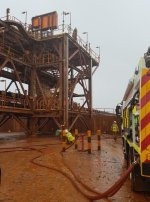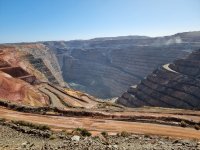- Joined
- Apr 25, 2023
- Messages
- 34
Good morning Team,
My name is Jesse and i operate an emergency services company in Perth, Western Australia.It is a private company that provide emergency services personnel, equipment and training to remote areas of the state mainly to mining operations. This includes fire fighter's, paramedics, security, nurses, doctors etc.
I'm currently updating our training material and was hoping to find a couple of experienced currently serving NYC fire fighters, preferably with high rise experience to bounce some technical questions off.
My background is as a fire and rescue / EMT operator mainly in underground (up to 1 mile UG) and heavy industrial enviroments.
Any advice on the following topics would be greatly appreciated as we are generally a little behind down here.
1. Electric vehicles, these are starting to push into mining (my main sector) in a big way. i was wondering if any of you have come across any effective agent to combat lithium Iron battery fires. anything that could prevent or help stop a thermal runaway? i have seen a few youtube clips on fire departments using giant fire blankets/tarps to try a mitigate. Is anyone aware of any agents or fire fighting media that is effective? i beleive the following link is of an Encapsulating agent called F500 which the manafactuerer make big claims on. However they sell this for $60,000 AUD for 1000L which converted for my americain friends is roughly $40,000 USD for 264 gallons.
Any coments or suggestions appreciated.
2. Dust explosions, we all know that saw mills, grain silo's, industrial bakery's can be high volitile if dust is ignited under the right conditions. I was wondering if any of you lads have come across a dust explosion caused by the dust generated from structural collapse?? It's concivably possible this could happend but i have not encountered it myself or worked with anyone that has. I was wondering if anyone from the US has encountered this??
I was wondering for structural fire fighting, do you guys use perculating hoses? or is this only used for wildfire? or have they been phased out in recent years replaced with non-perculating hose? also couplings, what are they made from (brass/Alumnium) and are they a fine thread??? I had the amazing opportunity to compete at an international mines rescue competition representing teamaustralia. it was held in salt lake city in 2007. We got to train at the reno fire science academy for 2 weeks and from memory we used fine threaded couplings. is this a national standard or does each state run it's own preference.
I appreciate your help in advance. I thought i would share a couple of pics of the West Australian mining sector. Theres even a pic of me and one of my staff in there on a site visit.
Stay safe folks, i hope to hear back from you.
All the best.
Jesse



My name is Jesse and i operate an emergency services company in Perth, Western Australia.It is a private company that provide emergency services personnel, equipment and training to remote areas of the state mainly to mining operations. This includes fire fighter's, paramedics, security, nurses, doctors etc.
I'm currently updating our training material and was hoping to find a couple of experienced currently serving NYC fire fighters, preferably with high rise experience to bounce some technical questions off.
My background is as a fire and rescue / EMT operator mainly in underground (up to 1 mile UG) and heavy industrial enviroments.
Any advice on the following topics would be greatly appreciated as we are generally a little behind down here.
1. Electric vehicles, these are starting to push into mining (my main sector) in a big way. i was wondering if any of you have come across any effective agent to combat lithium Iron battery fires. anything that could prevent or help stop a thermal runaway? i have seen a few youtube clips on fire departments using giant fire blankets/tarps to try a mitigate. Is anyone aware of any agents or fire fighting media that is effective? i beleive the following link is of an Encapsulating agent called F500 which the manafactuerer make big claims on. However they sell this for $60,000 AUD for 1000L which converted for my americain friends is roughly $40,000 USD for 264 gallons.
Any coments or suggestions appreciated.
2. Dust explosions, we all know that saw mills, grain silo's, industrial bakery's can be high volitile if dust is ignited under the right conditions. I was wondering if any of you lads have come across a dust explosion caused by the dust generated from structural collapse?? It's concivably possible this could happend but i have not encountered it myself or worked with anyone that has. I was wondering if anyone from the US has encountered this??
I was wondering for structural fire fighting, do you guys use perculating hoses? or is this only used for wildfire? or have they been phased out in recent years replaced with non-perculating hose? also couplings, what are they made from (brass/Alumnium) and are they a fine thread??? I had the amazing opportunity to compete at an international mines rescue competition representing teamaustralia. it was held in salt lake city in 2007. We got to train at the reno fire science academy for 2 weeks and from memory we used fine threaded couplings. is this a national standard or does each state run it's own preference.
I appreciate your help in advance. I thought i would share a couple of pics of the West Australian mining sector. Theres even a pic of me and one of my staff in there on a site visit.
Stay safe folks, i hope to hear back from you.
All the best.
Jesse



Last edited:
